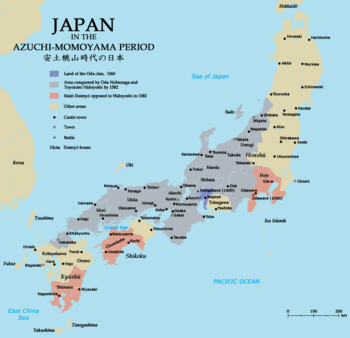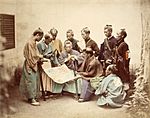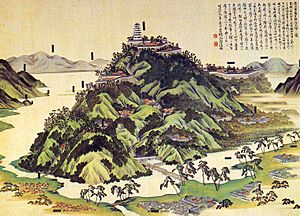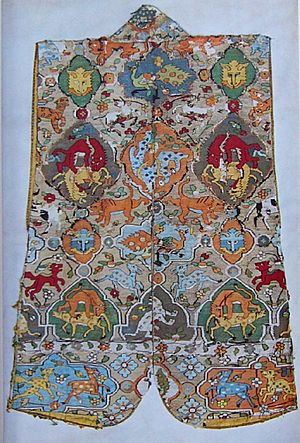Azuchi–Momoyama period facts for kids
Quick facts for kids
Azuchi–Momoyama period
|
|||||||||||||
|---|---|---|---|---|---|---|---|---|---|---|---|---|---|
| 1568–1600 | |||||||||||||
 |
|||||||||||||
| Capital | |||||||||||||
| Largest city | |||||||||||||
| Common languages | Late Middle Japanese | ||||||||||||
| Government | Feudal confederal military dictatorship | ||||||||||||
| Emperor | |||||||||||||
|
• 1557–1586
|
Ōgimachi | ||||||||||||
|
• 1586–1611
|
Go-Yōzei | ||||||||||||
| Shōgun | |||||||||||||
|
• 1568–1573
|
Ashikaga Yoshiaki | ||||||||||||
|
• 1582–1582
|
Akechi Mitsuhide | ||||||||||||
| Head of government | |||||||||||||
|
• 1583–1598
|
Oda Nobunaga | ||||||||||||
|
• 1582–1582
|
Akechi Mitsuhide | ||||||||||||
|
•
|
Toyotomi Hideyoshi | ||||||||||||
|
• 1598–1600
|
Council of Five Elders | ||||||||||||
| Legislature |
|
||||||||||||
| History | |||||||||||||
|
• Oda Nobunaga captures Kyoto
|
October 18, 1568 | ||||||||||||
|
• Ashikaga shogunate abolished
|
September 2, 1573 | ||||||||||||
|
• Death of Oda Nobunaga
|
June 21, 1582 | ||||||||||||
|
• Battle of Yamasaki
|
July 2, 1582 | ||||||||||||
|
• Death of Toyotomi Hideyoshi
|
September 18, 1598 | ||||||||||||
|
• Council of Five Elders
|
1598 | ||||||||||||
| October 21, 1600 | |||||||||||||
| Currency | Mon | ||||||||||||
|
|||||||||||||
|
|||||||||||||
 |
|---|
|
The Azuchi–Momoyama period (安土桃山時代, Azuchi–Momoyama jidai) was a time in Japanese history from 1568 to 1600. It was the last part of the Sengoku period, also known as the "Warring States period."
During this time, Japan was unified after many years of civil war. Two powerful leaders, Oda Nobunaga and Toyotomi Hideyoshi, brought the country together. The period is named after Nobunaga's Azuchi Castle and Hideyoshi's Momoyama Castle. It was a time of big changes in Japanese society, moving from old traditions to a more modern era.
Contents
What Was the Azuchi–Momoyama Period?
This period began when Oda Nobunaga entered Kyoto in 1568. He aimed to bring order to Japan, which had been divided by many powerful warlords called daimyōs. Nobunaga started the process of unification, and after he died, Toyotomi Hideyoshi finished it.
The Azuchi–Momoyama period ended in 1600 with the Battle of Sekigahara. This battle led to the start of the Tokugawa Shogunate, which ruled Japan for over 250 years.
Oda Nobunaga: The First Unifier
In the mid-1500s, Japan was in chaos. The old government, the Ashikaga Shogunate, had lost its power. Many daimyōs fought each other for control.
In 1568, Oda Nobunaga marched into Kyoto, Japan's capital. He helped Ashikaga Yoshiaki become the new shōgun (military ruler). This event officially started the Azuchi–Momoyama period. However, Nobunaga soon removed Yoshiaki and took control himself in 1573. He wanted to unify Japan by force.
Nobunaga was known for being a strong and sometimes harsh leader. He made economic changes to help trade, like creating "free markets" called rakuichi-rakuza. He also welcomed new ideas and technologies from Europe, especially new weapons like the arquebus (an early type of rifle).
Nobunaga was interested in foreign cultures, including Western Christian ideas. He protected Christianity but also fought against powerful Buddhist monasteries that resisted him.
Nobunaga's Challenges and Victories
Many daimyōs and even some Buddhist groups formed alliances against Nobunaga. One of his biggest challenges came from Takeda Shingen, a very powerful daimyō. Shingen's army defeated Nobunaga's ally, Tokugawa Ieyasu, in the Battle of Mikatagahara in 1573. However, Shingen suddenly died, saving Nobunaga from a major defeat.
Nobunaga continued his campaigns. In 1575, he won a huge victory against the Takeda clan at the Battle of Nagashino. He used arquebuses effectively against the Takeda's famous samurai cavalry. This battle changed how wars were fought in Japan.
In 1582, Nobunaga was on his way to help one of his generals, Toyotomi Hideyoshi. While resting in Kyoto, he was attacked by one of his own generals, Akechi Mitsuhide. Nobunaga died in this event, known as the Honnō-ji Incident.
Toyotomi Hideyoshi Completes Unification
After Nobunaga's death, his generals rushed to take revenge and gain power. Nobunaga's oldest son also died, leaving no clear successor.
Toyotomi Hideyoshi, who started as a common foot soldier, quickly made a truce with his enemies and rushed back to defeat Akechi Mitsuhide at the Battle of Yamazaki. Hideyoshi then became the most powerful leader. He made sure Nobunaga's infant grandson, Sanpōshi, became the heir.
Hideyoshi continued to defeat other powerful daimyōs. By 1590, he defeated the Later Hōjō clan at the Siege of Odawara (1590). This victory meant that Japan was finally unified under his rule. He was given the important title of kanpaku, which meant he had civil and military control over all of Japan.
Japan Under Hideyoshi's Rule
Hideyoshi introduced many changes to Japan. He conducted a national land survey in 1598, which measured how much rice each area produced. This helped him understand and control the country's wealth.
He also made rules to stabilize society. He removed tolls on roads to help trade. He also ordered a "sword hunt" (katanagari), collecting weapons from farmers to prevent rebellions and keep social classes separate.
Hideyoshi and Christianity
Hideyoshi was cautious about Christianity. In 1587, he ordered Christian missionaries to leave Japan, especially from Kyushu. In 1597, he ordered the arrest and execution of twenty-six Christians in Nagasaki. These events, known as the 26 Martyrs of Japan, showed his concern about foreign influence.
Korean Campaigns
Hideyoshi had a big dream: to conquer China. To do this, he needed to pass through Korea. In 1592, he sent a large army to invade Korea. The Japanese forces quickly took Seoul and reached Pyongyang. However, the Chinese emperor sent help to Korea, and the Japanese were pushed back.
Peace talks followed, but they failed because Hideyoshi made demands that China and Korea would not accept. A second invasion of Korea began in 1597, but it also failed. The Korean navy, led by Admiral Yi Sun-sin, was very effective, and China became more involved.
When Hideyoshi died in 1598, his young son, Toyotomi Hideyori, was only five years old. This made the situation in Japan unstable, and the Japanese armies withdrew from Korea.
The End of an Era: Tokugawa Shogunate Begins
Before he died, Hideyoshi appointed a group of five powerful lords, called the Council of Five Elders, to rule until his son Hideyori grew up. However, peace did not last long.
The most powerful of these lords was Tokugawa Ieyasu. He fought against Ishida Mitsunari, who supported the Toyotomi family. This led to the Battle of Sekigahara in 1600. Ieyasu won this battle, which marked the end of the Azuchi–Momoyama period and the Toyotomi family's rule.
Three years later, Ieyasu became the Sei-i Tai-shōgun and established the Edo bakufu. This new government ruled Japan peacefully for over 250 years, until the Meiji Restoration in 1868.
Culture and Society
The Azuchi–Momoyama period saw cities grow and the merchant class become more important. Castles built during this time were grand and decorated with gold. This showed the power of the daimyōs and a new artistic style. A unique art style called Nanban emerged, showing European priests and traders.
The tea ceremony also became very popular. Both Nobunaga and Hideyoshi loved this art form. They collected tea bowls and supported famous tea masters like Sen no Rikyū.
Hideyoshi also tried to control international trade through the port of Nagasaki. Japanese ships, called red seal ships, traded with countries like Malaysia, the Philippines, and Thailand.
Timeline of Key Events
- 1568: Nobunaga enters Kyoto, starting the Azuchi–Momoyama period.
- 1573: Nobunaga removes the Ashikaga bakufu and takes control of central Japan.
- 1575: Nobunaga defeats the Takeda clan at the Battle of Nagashino.
- 1582:
- Incident at Honnō-ji: Nobunaga is killed by Akechi Mitsuhide.
- Hideyoshi defeats Mitsuhide at the Battle of Yamazaki.
- Hideyoshi begins his land surveys (Taikō kenchi).
- 1586: Osaka Castle is built by Toyotomi Hideyoshi.
- 1588: Hideyoshi orders the "Sword hunt" (katanagari).
- 1590: Hideyoshi defeats the Hōjō clan, unifying Japan.
- 1591: Sen no Rikyū dies.
- 1592: Hideyoshi begins the first invasion of Korea.
- 1597:
- Second invasion of Korea begins.
- The 26 Martyrs of Japan are executed.
- 1598: Hideyoshi dies.
- 1600: Ieyasu wins the Battle of Sekigahara, ending the Azuchi–Momoyama period.
See also
 In Spanish: Período Azuchi-Momoyama para niños
In Spanish: Período Azuchi-Momoyama para niños
- Golden Tea Room
- Azuchi Screens
Images for kids






